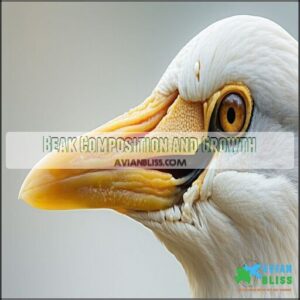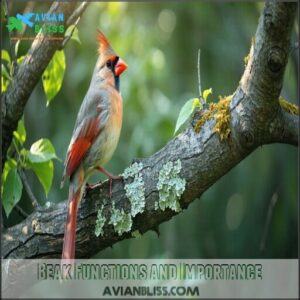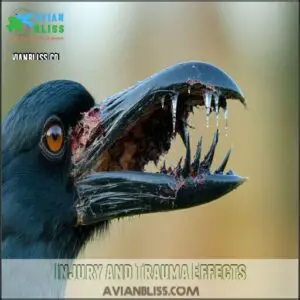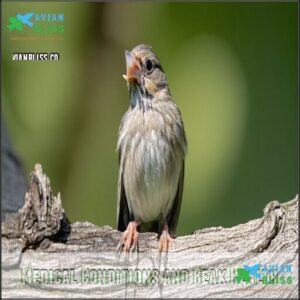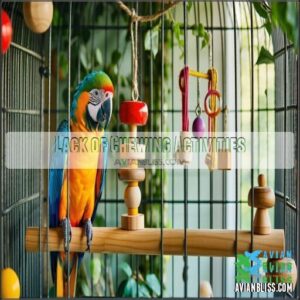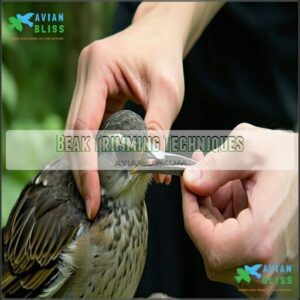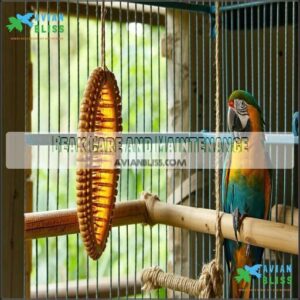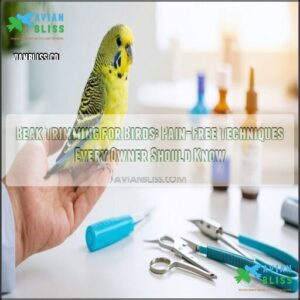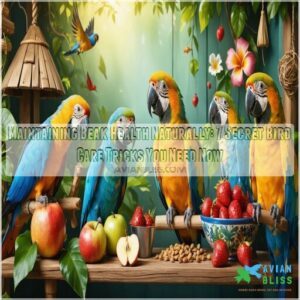This site is supported by our readers. We may earn a commission, at no cost to you, if you purchase through links.
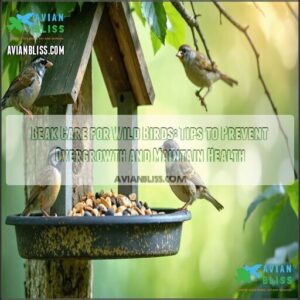
Birds naturally keep their beaks in shape by pecking at textured surfaces like rough branches or chewing on materials like bark and cuttle bones.
A healthy diet also plays a big role, with foods having hard textures, paired with calcium-rich options, supporting strong beaks and preventing overgrowth.
Keep an eye on any signs of trouble like difficulty eating or swelling—those could signal deeper issues, and remember that Nature’s tools are often the best, and a little attention goes a long way in promoting healthy, happy birds.
Table Of Contents
- Key Takeaways
- Beak Anatomy Basics
- Causes of Beak Overgrowth
- Beak Trimming Techniques
- Beak Care and Maintenance
- Beak Problem Prevention
- Frequently Asked Questions (FAQs)
- How do you keep a bird’s beak healthy?
- How do you treat a wild bird with a broken beak?
- What does an unhealthy bird’s beak look like?
- How do wild birds repair beak damage naturally?
- How does seasonal diet impact beak condition?
- Can wild birds develop infections from beak injuries?
- How do wild birds naturally heal broken beaks?
- Are seasonal diets in the wild enough for beak health?
- How do weather changes impact wild bird beaks?
- What are common predators that target birds beaks?
- Conclusion
Key Takeaways
- Offer textured surfaces, cuttlebones, and chew toys to help birds naturally file and maintain their beaks.
- Provide a balanced diet with hard and calcium-rich foods to strengthen beaks and prevent overgrowth.
- Watch for signs like swelling, discoloration, or difficulty eating to catch beak issues early.
- Create natural foraging opportunities with branches and food puzzles to mimic wild bird habits.
Beak Anatomy Basics
A bird’s beak might look simple, but it’s a complex structure made of bone, skin, and keratin that grows continuously.
It’s not just for eating—birds use their beaks for everything from preening to climbing, making it an indispensable tool for survival.
Beak Composition and Growth
A bird’s beak is a masterpiece of nature, blending living tissue, keratin, and bone structure seamlessly.
This dynamic tool isn’t static—it grows continuously, adapting to the bird’s needs.
- Keratin layers create a glossy, protective shield.
- Bone structure forms a strong yet lightweight framework.
- Beak development relies on environmental and nutritional growth factors.
- Sensory receptors in the beak make it highly responsive.
It’s a true wonder of nature’s design!
Beak Functions and Importance
A bird’s beak is a multitasking marvel, much like your favorite pocket tool.
Its functions are as diverse as they’re essential. Beaks aren’t just for eating—they excel at grooming feathers, climbing tricky spots, and even fending off predators with their sharp edges.
They’re a key sensory organ too, finely tuned for precise actions like picking tiny seeds or preening feathers.
Communication? Beaks do that too, often crafting unique signals for social bonding.
Beaks are made of continuously growing keratin, similar to human fingernails.
Beak Sensitivity and Nerve Endings
Your bird’s beak is an intricate sensory masterpiece, full of nerve endings essential for sensing the world. Beak sensitivity allows for precise pain perception, responding to tiny changes in pressure or temperature.
This sharp sensory function is why beak injuries—even minor ones—can be so painful and disruptive. Prioritizing care prevents nerve damage and helps maintain proper functionality. Address injuries promptly to avoid long-term complications.
- Thermal Detection: Birds sense temperature changes through their beak.
- Beak Trauma Risks: Damage can impair feeding or grooming.
- Sensory Functions: Critical for exploring their environment.
- Beak Anatomy Check-ups: Regular care helps prevent injuries.
Causes of Beak Overgrowth
Beak overgrowth can happen when birds don’t get the right diet or enough chewing opportunities, which are essential for natural wear.
Injuries, certain illnesses, and even genetics can also disrupt the beak’s balance, making daily life harder for your feathered friends, due to the lack of chewing opportunities.
Injury and Trauma Effects
Beak injuries in wild birds can cause serious survival issues, especially if not addressed quickly.
Swift action on beak injuries can mean the difference between survival and struggle for wild birds.
Wildlife rehabilitators often deal with:
- Misalignment problems that make feeding nearly impossible.
- Splitting risks, which create openings for infection and permanent deformity.
- Challenging bleeding control, where even small wounds can turn deadly.
Swift avian first aid is key.
Handle beak trauma carefully to avoid worsening structural damage and focus on deformity prevention for long-term recovery.
Medical Conditions and Beak Health
Liver disease, viral infections, and metabolic disorders aren’t just buzzwords—they’re common reasons behind bird beak problems.
Calcium deficiency quietly weakens beak structure, while genetic predispositions amplify growth issues.
These medical conditions can compromise bird beak health, obstructing your feathered friend’s ability to forage or communicate, and recognizing these challenges early guarantees proper avian beak care and supports their survival in the wild.
Poor Diet and Malnutrition Risks
A poor diet spells trouble for birds, especially if you’re feeding just seeds.
Seed-only diets rob wild birds of essential nutrients, leading to:
- Vitamin deficiencies that weaken beaks and bodies.
- Metabolic disorders linked to organ strain and brittle beaks.
- Calcium deficiencies causing fragile beak structures.
Mixing pellets, fruits, and vegetables guarantees wild bird nutrition and keeps their beaks strong, sharp, and healthy.
Addressing these deficiencies can prevent excessive beak growth.
Lack of Chewing Activities
When wild birds lose natural chewing opportunities in captivity, beak overgrowth sneaks in unnoticed.
Keep your bird’s beak active and healthy by mimicking nature’s routines.
Try these enrichment ideas:
- Add wooden toys for constant gnawing.
- Set up food puzzles for fun and beak exercise.
- Provide textured perches for natural wear.
- Rotate the cage layout to encourage exploration.
Support natural behaviors, prevent overgrowth!
Beak Trimming Techniques
Trimming a bird’s beak requires steady hands, the right tools, and careful attention to safety.
By mastering proper techniques, you’ll help prevent discomfort and keep your bird healthy without causing unnecessary stress.
Professional Trimming Methods
Overgrown beaks sometimes need professional trimming.
Vets carefully choose from methods like Hot-blade Technique, Electrical Trimming, or Infra-red Methods, ensuring Anesthesia Safety and Injury Prevention. Tools vary, but precision always matters to avoid harm.
Here’s a quick comparison:
| Method | Benefits | Risks |
|---|---|---|
| Hot-blade Technique | Reduces bleeding | Potential thermal damage |
| Electrical Trimming | Faster, minimal pain | Requires expertise |
| Infra-red Methods | Cauterizes, prevents infections | Costly, less accessible |
Good care reduces Post-trim Infection risks!
Tool Selection and Safety Precautions
Choosing the right tools for beak trimming is like picking the perfect Swiss Army knife—versatility and precision matter.
Clipper types range from basic to advanced, so focus on those designed for birds.
Safe handling and proper restraint methods reduce stress. Always follow disinfection protocols and have supplies for bleeding control ready.
Consider exploring options for specialized trimming equipment to guarantee superior beak health. Use gentle pressure and avoid rushing, as injury prevention is key.
Tool selection guarantees a smooth, safe trimming experience.
Anesthesia Options and Bird Comfort
Keeping your bird calm during beak trims calls for proper anesthesia like isoflurane, which minimizes stress and guarantees safety.
Injectable sedatives work for unique cases, though they risk more side effects.
Key steps include:
- Use precise dosing with capnography for monitoring signs.
- Focus on pain management to ease discomfort.
- Provide a quiet recovery environment to reduce stress and aid healing.
Post-Trim Care and Monitoring
After trimming, create a stress-free environment to help your bird recover.
Keep an eye out for distress signs like eating or drinking difficulties.
Focus on:
- Pain management: Offer soft foods for comfort.
- Infection prevention: Always keep the beak dry and clean.
- Professional follow-up: Regular inspections or consult a vet if you notice bleeding, swelling, or deformities.
Aftercare matters!
Beak Care and Maintenance
You can help wild birds keep their beaks healthy by providing opportunities for natural wear and access to chewable items like cuttlebones.
A balanced diet, regular check-ups, and textured surfaces mimic the wild and prevent overgrowth.
Natural Wear and Tear Promotion
In nature, wild bird beaks stay healthy through natural wear and tear from daily activities.
Beaks are kept sharp by foraging opportunities, rubbing on bark, and grinding food. Mimicking habitat conditions like using varied perch materials is key to natural beak maintenance.
| Action | Benefits | Example |
|---|---|---|
| Foraging Opportunities | Promotes natural wear and tear | Hanging seed feeders |
| Perch Materials | Supports beak health | Natural wooden branches |
| Wild Bird Feeding | Aids wear during meals | Cracking nuts or seeds |
This guarantees stronger, healthier beaks for your feathered friends, through varied perch materials and other means.
Chew Toys and Cuttle Bones Benefits
Chew toys and cuttlebones are more than distractions—they help keep beaks healthy and naturally filed while preventing overgrowth.
Birds love to chew, so offering safe, durable options satisfies this instinct and keeps their beaks in top shape.
Here’s why they matter:
- Calcium Source: Cuttlebones strengthen beaks and bones.
- Beak Exercise: Chewing keeps beaks balanced and functional.
- Mental Enrichment: Mimics foraging, keeping birds happy.
- Natural Filing: Maintains proper beak length.
Pick species-appropriate chew toys with bird-safe materials.
You can find various toy options online.
Your feathered friend will thank you with a healthier, happier beak!
Balanced Diet and Beak Health
A healthy bird diet fuels strong, sharp beaks.
Combine pellet benefits with seed variety, offering balanced nutrition that promotes proper bird beak health.
Dietary calcium from cuttle bones or hard nuts strengthens beaks, while fruits like apples and crunchy veggies add abrasion to prevent overgrowth.
Don’t shy away from experimenting with wild bird favorites; a diverse menu keeps them happy and healthy.
Conditioning perches also aid in natural beak filing.
Wild birds thrive on a balanced diet, so mix it up and watch those beaks stay in top shape with proper bird beak health, and remember to provide conditioning perches for natural filing, which supports strong, sharp beaks.
Regular Veterinary Check-Ups
Catching problems early is key, and regular bird health checkups with an avian vet make all the difference.
Routine inspections facilitate early detection of hidden issues, like beak misalignment, before they spiral.
Preventative care, paired with professional advice, keeps your bird’s overall health on track, and trust veterinary care to guarantee a strong, functional beak and a happy life.
Beak Problem Prevention
You can help wild birds avoid beak problems by spotting early warning signs and encouraging natural wear.
Simple steps like providing textured surfaces, conditioning perches, and keeping their beaks clean make a big difference.
Early Warning Signs Detection
Spotting early warning signs keeps birds healthy and happy. Pay attention to subtle changes in their behavior or appearance. Notice if eating habits shift, their feather condition worsens, or vocalizations change.
Regular observation uncovers subtle signs that can alert you to potential problems. One such sign can be holes or pitting in the beak.
Some common bird behavior signs to watch for include:
- **Swelling, discharge, or discoloration around the beak.
- **Uncharacteristic aggression or sluggishness.
- **Difficulty eating or a preference for soft food.
- **Feather plucking or unusual grooming patterns.
Quick action supports their recovery.
Conditioning Perches and Beak Filing
Maintaining a wild bird’s beak shape starts with thoughtful perch materials.
Conditioning perches with the right texture can promote natural filing and healthy wear, mimicking how birds care for their beaks in the wild. Avoid surfaces too rough—they might irritate feet.
Consider specialized perch options for ideal beak health.
Try these options:
- Manzanita or natural branches for durability.
- Safety pumice perches for gentle filing.
- Cuttle bones for exercise and texture importance.
- Textured perches for light abrasion.
Beak Cleaning and Hygiene Practices
Birds keep their beaks sharp and clean by wiping them against natural abrasives like textured perches, which remove dirt and debris.
Fresh water rinsing is another favorite, as it naturally supports hygiene while keeping them refreshed. Beak wiping also spreads preen gland oil, aiding feather maintenance.
You can encourage these habits with safe, enriching environments that include water rinsing stations and hygiene products. Simple preventative measures like this maintain your bird’s beak health without stress, and support overall beak health.
Textured Surfaces and Natural Branches Benefits
Wild birds rely on textured surfaces, like bark, for natural foraging and surface abrasion, essential for beak health.
Adding natural branches to your yard promotes beak maintenance and exercise, while also supporting hygiene promotion.
Branch foraging encourages mental enrichment and keeps birds engaged.
These simple tweaks mimic their environment, helping wild birds maintain healthy, functional beaks without hassle.
Frequently Asked Questions (FAQs)
How do you keep a bird’s beak healthy?
Give your bird safe chew toys, cuttlebones, and textured perches to naturally file its beak.
A balanced diet with fresh veggies and pellets supports growth.
Regularly check for issues, and consult your vet for concerns.
How do you treat a wild bird with a broken beak?
Ever seen a bird with a chipped beak and wondered how to help?
Contact a wildlife rehab center immediately, as they can stabilize injuries, provide pain relief, and guarantee proper healing without stressing the bird.
What does an unhealthy bird’s beak look like?
An unhealthy bird’s beak might look overgrown, flaky, or discolored, with cracks or uneven edges.
You might notice swelling near its base or an unusual texture.
If it’s brittle or asymmetrical, that’s another red flag.
How do wild birds repair beak damage naturally?
A cracked beak’s like a chipped tooth—you’ll see wild birds using bark, stones, or tough seeds to smooth edges.
Their diet, constant gnawing, and natural foraging help wear down and reshape damaged beak areas efficiently.
How does seasonal diet impact beak condition?
Seasonal diets influence beak health by providing nutrients critical for strength and growth.
For example, harder seeds in colder months naturally file beaks, while softer foods during spring might reduce wear, increasing the chance of overgrowth.
Can wild birds develop infections from beak injuries?
A broken gate can invite trouble—wild birds with beak injuries risk infections from bacteria or fungi.
These infections often spread quickly, affecting feeding and survival.
Clean wounds and strengthen habitats to help them stay healthy.
How do wild birds naturally heal broken beaks?
Wild birds can heal minor beak injuries through natural growth and wear, aided by diet and foraging.
Severe breaks mightn’t fully heal, but birds adapt, using modified behaviors to survive and thrive despite challenges, with natural growth being a key factor in their ability to cope.
Are seasonal diets in the wild enough for beak health?
Did you know birds’ beaks grow continuously, like our fingernails?
Seasonal diets often provide enough nutrients for strong beaks, but food scarcity or imbalanced nutrition can sometimes lead to overgrowth, cracks, or weakened structure, which is a result of imbalanced nutrition.
How do weather changes impact wild bird beaks?
Weather shifts can affect wild bird beaks by altering food availability, moisture levels, and wear patterns.
For instance, droughts might limit soft food sources, while icy conditions can challenge foraging and increase the risk of cracking, which is a significant factor in wear patterns.
What are common predators that target birds beaks?
A bird’s beak can face danger from predators like snakes, raccoons, or hawks, which view it as a strike point.
Sharp-eyed attackers aim for the head or beak, disabling the bird’s survival tools instantly.
Conclusion
Did you know bird beaks grow continuously, much like human fingernails?
That’s why beak care for wild birds is essential for their survival. By providing the right environment—offering textured surfaces, chewable materials, and a balanced diet—birds can naturally maintain their beaks’ health and function.
Keep an eye out for signs like swelling or difficulty eating, as early detection prevents bigger problems. A little effort goes a long way in supporting these amazing creatures and their remarkable tools!

